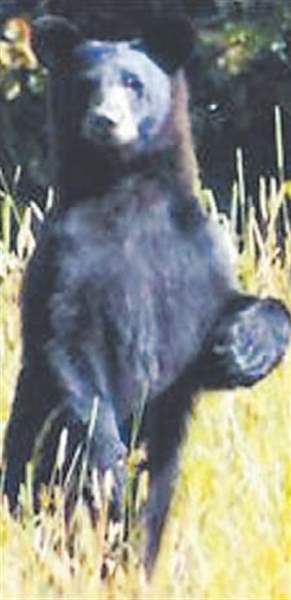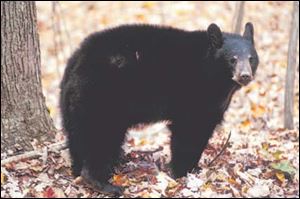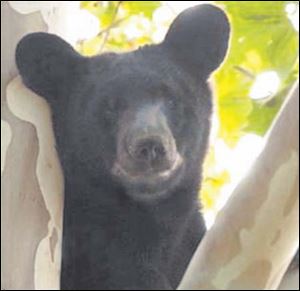
Toledo Magazine: something else you might see in the woods this autumn
10/21/2007
A young male black bear, perhaps seeking new territory, stands up for a better look.

A young male black bear, perhaps seeking new territory, stands up for a better look.
Mike Mainhart, who lives in the rural community of Vienna Center in Trumbull County, not far from northeast Ohio s border with Pennsylvania, heard an uproar behind one of his outbuildings in late summer.
His prize beagle hunting dog was barking and howling and carrying on wildly in his kennel, obviously very upset at something out back. Mr. Mainhart turned the corner and there, next to a little pond 50 yards away, stood a black bear, a male of perhaps 250 pounds.
It wasn t a cub, assured Mr. Mainhart, a veteran wildlife photographer and hunter. He quickly grabbed a camera from the seat of his pickup truck and started snapping away as the bear proceeded to depart.
It was no threat. It did what he was supposed to do it ran, Mr. Mainhart said. It never did bother anybody and it finally moved on.
This bear encounter ended the way most of them do harmlessly. But black bears still are scarce enough in Ohio to be a novelty, unlike neighboring Pennsylvania and Ohio, which are home to 15,000 to 18,000 bears each. Michigan likewise has a large bear population, numbering about 18,000 to 20,000 animals.

Best places for Ohio black bears (map right) are in forested areas in northeast Ohio (Ashtabula, Geauga, Lake, Trumbull, and Tuscarawas counties), and southeast Ohio (Athens, Jackson, Lawrence, Monroe, and Washington counties). • Weight: Male 300 lbs. Female 175 lbs. • Height: At shoulder: 3 ft. • Standing: 5-6 ft tall. • Lifespan: Up to 25 years. • Typical diet: Grass, fruit, nuts, insects, fi sh, and mammals.
Such numbers dwarf Ohio s infant population, which numbers just 50 to 100 resident bears. But bears indeed do live in forested tracts of the northeast and southeast corners of Ohio, notes Suzie Prange, a research biologist with the state s Waterloo Wildlife Research Station near Athens.
When we get sightings of sows with cubs, we know we have a small resident breeding population, she said. The neatest thing about them is they came back on their own.
The spread of European-based settlement wiped out bears in Ohio by 1850, both by clearing of forests for towns and agriculture and by killing bears to protect livestock and crops. Today s eastern black bears, in fact, are considered much more docile than their western cousins because their more aggressive ancestors were culled out of the gene pool, eventually leaving more timid and reclusive animals to procreate.
In 2006 the Ohio Division of Wildlife recorded 113 sightings of black bears, representing 67 individuals. That number was up from 105 in 2005. The numbers are expected to increase, according to the Ohio Division of Wildlife, because of the large amount of unoccupied, suitable forest habitat available in eastern Ohio.

Bears most likely can be found in Ashtabula, Geauga, Lake, Trumbull, and Tuscarawas counties in the northeast, and Athens, Jackson, Lawrence, Monroe, and Washington counties in the southeast. More recently Mahoning, Stark, and Ashland counties have been added to the likely list.
But that does not exclude them from most anywhere in the state, at least when it comes to wandering if not resident bears. An accompanying chart shows counties where bears have been seen or suspected since 1993.
A young, 100-pound male bear, or boar, was seen in western Lucas County two years ago. It was thought to be a wanderer from southern Michigan and eventually it was struck and killed by a motor vehicle.
A lot of sightings can be sub-adult males out looking for mates or their own territories, said biologist Prange. They may wander hundreds of miles. By contrast, sows, especially with cubs, stick to much more limited territories and rarely roam widely.
Hunters and hikers afield this fall in prime bear locales in Ohio yet may see a bruin or two. Enjoy them from afar.
Bears, while not necessarily dangerous and aggressive, are large, strong wild animals and should be treated with distance and respect. In the unlikely event of a bear attack, fight back as you continue to retreat from an area. The Pennsylvania Game Commission reports that bears have been driven away with rocks, sticks, binoculars, car keys, and even bare hands.

A young Ohio bear, likely a male, rests in the crotch of a sycamore tree.
Purposely feeding them can be especially disastrous, for bears may not know where a hand ends and a treat begins. Too, cases in which bears have attacked and injured humans even if the human is at fault for the encounter usually end up badly for the bear.
In bear country, keep pet food or other such temptations in sealed containers. Keep lids on garbage cans. Let common sense prevail. Then you can enjoy an animal that truly puts some wild in Ohio.
Contact Steve Pollick at:spollick@theblade.comor 419-724-6068.